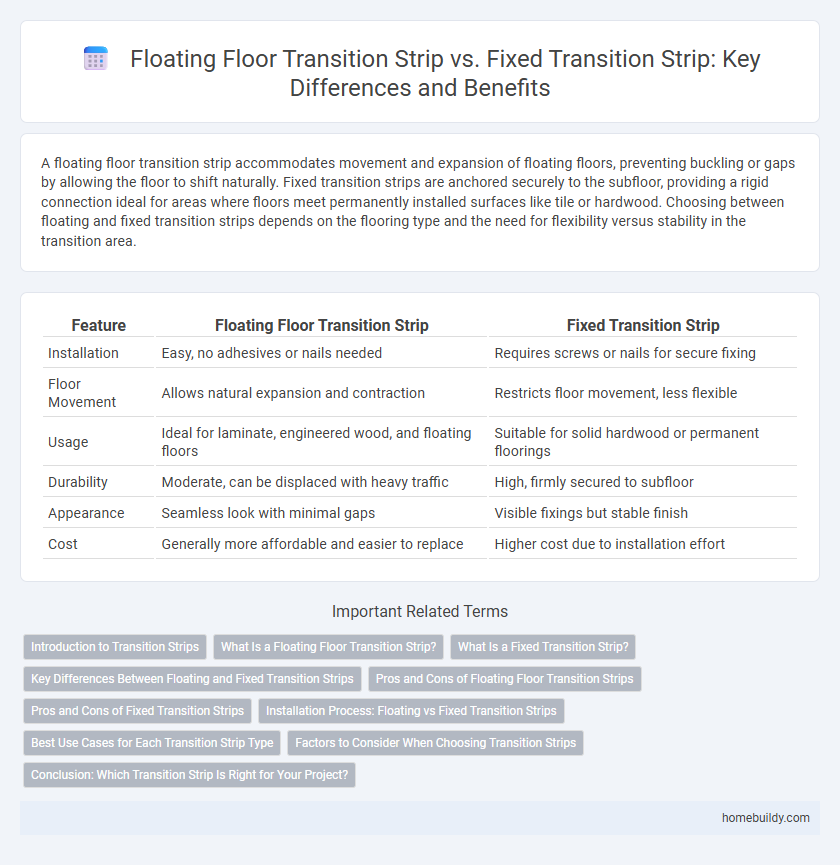A floating floor transition strip accommodates movement and expansion of floating floors, preventing buckling or gaps by allowing the floor to shift naturally. Fixed transition strips are anchored securely to the subfloor, providing a rigid connection ideal for areas where floors meet permanently installed surfaces like tile or hardwood. Choosing between floating and fixed transition strips depends on the flooring type and the need for flexibility versus stability in the transition area.
Table of Comparison
| Feature | Floating Floor Transition Strip | Fixed Transition Strip |
|---|---|---|
| Installation | Easy, no adhesives or nails needed | Requires screws or nails for secure fixing |
| Floor Movement | Allows natural expansion and contraction | Restricts floor movement, less flexible |
| Usage | Ideal for laminate, engineered wood, and floating floors | Suitable for solid hardwood or permanent floorings |
| Durability | Moderate, can be displaced with heavy traffic | High, firmly secured to subfloor |
| Appearance | Seamless look with minimal gaps | Visible fixings but stable finish |
| Cost | Generally more affordable and easier to replace | Higher cost due to installation effort |
Introduction to Transition Strips
Transition strips bridge the gap between different flooring surfaces, ensuring a smooth and visually appealing connection. Floating floor transition strips accommodate expansion and contraction by floating above the subfloor, ideal for laminate or engineered wood floors. Fixed transition strips are anchored directly to the subfloor, providing a stable, permanent connection commonly used with hardwood or tile flooring.
What Is a Floating Floor Transition Strip?
A floating floor transition strip is designed to accommodate the natural expansion and contraction of floating floors, such as laminate or engineered wood, without being fixed directly to the subfloor. It allows the floor to move freely, preventing buckling or damage by bridging two different flooring surfaces or covering expansion gaps. This type contrasts with fixed transition strips, which are securely attached to the substrate and used in situations where floor movement is minimal or non-existent.
What Is a Fixed Transition Strip?
A fixed transition strip is a flooring accessory securely fastened to the subfloor, providing a stable connection between two different floor surfaces or levels. Unlike floating floor transition strips, which move with the flooring during expansion and contraction, fixed strips remain stationary, ensuring durability and a solid boundary. Commonly used in areas with minimal movement, fixed transition strips help prevent tripping hazards and create a clean, professional finish.
Key Differences Between Floating and Fixed Transition Strips
Floating floor transition strips accommodate expansion and contraction by allowing movement between flooring sections, making them ideal for laminate and engineered wood floors. Fixed transition strips are securely attached to the subfloor, providing a stable connection suited for hardwood or tile floors that do not require as much flexibility. Key differences include installation methods, compatibility with specific flooring types, and the ability to manage floor movement and expansion gaps.
Pros and Cons of Floating Floor Transition Strips
Floating floor transition strips offer easy installation and flexibility, accommodating floor movement and expansion without the need for nails or glue, which reduces potential damage and simplifies future repairs. They are ideal for floating floors like laminate or engineered wood but may have less stability and durability compared to fixed transition strips, which are anchored securely to the subfloor. One drawback is that floating strips can sometimes shift or create gaps over time, especially in high-traffic areas, whereas fixed strips provide a more permanent, solid transition.
Pros and Cons of Fixed Transition Strips
Fixed transition strips provide a secure and stable connection between different flooring types, minimizing movement and reducing trip hazards. They are ideal for permanent installations where floors do not expand or contract significantly, offering durability and a clean, continuous finish. However, the rigidity of fixed strips can lead to buckling or damage in environments with fluctuating humidity or temperature.
Installation Process: Floating vs Fixed Transition Strips
Floating floor transition strips are installed using a click-lock mechanism or adhesive tape, allowing the flooring to expand and contract naturally without being anchored to the subfloor. Fixed transition strips require screws or nails to secure them firmly to the subfloor, providing a more permanent and stable connection between different flooring surfaces. The floating installation process is quicker and less invasive, while fixed strips offer greater durability and resistance to movement over time.
Best Use Cases for Each Transition Strip Type
Floating floor transition strips are ideal for areas where the flooring needs to expand and contract, such as in rooms with hardwood or laminate floors that are prone to seasonal movement. Fixed transition strips are best suited for stable flooring installations like tile-to-carpet transitions where expansion is minimal, ensuring a secure and permanent edge. Choosing the correct transition strip type improves durability and maintains the aesthetic continuity between different flooring surfaces.
Factors to Consider When Choosing Transition Strips
Floating floor transition strips accommodate expansion and contraction by allowing movement between flooring types, making them ideal for areas with fluctuating humidity and temperature. Fixed transition strips provide a rigid connection, offering stability and durability in environments with minimal movement or where a seamless, secure edge is desired. Key factors to consider include flooring material compatibility, room conditions such as moisture levels, and the level of traffic to ensure both functionality and aesthetic integration.
Conclusion: Which Transition Strip Is Right for Your Project?
Floating floor transition strips provide flexibility by accommodating floor movement and expansion, making them ideal for floating or laminate floors that expand and contract. Fixed transition strips offer a more permanent, stable solution suited for floors that do not shift, such as hardwood or tile, ensuring a tight and durable connection. Choosing the right transition strip depends on your flooring type and installation needs, with floating strips preferred for ease of maintenance and flexibility, while fixed strips excel in areas requiring robust, immovable joins.
Floating floor transition strip vs Fixed transition strip Infographic

 homebuildy.com
homebuildy.com